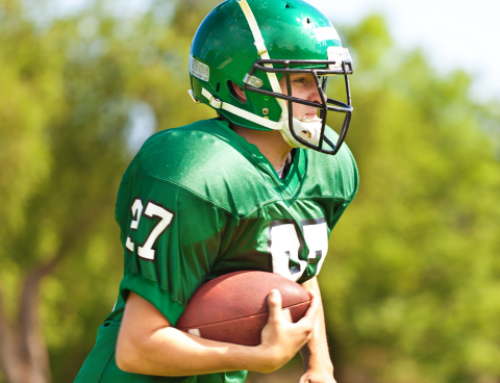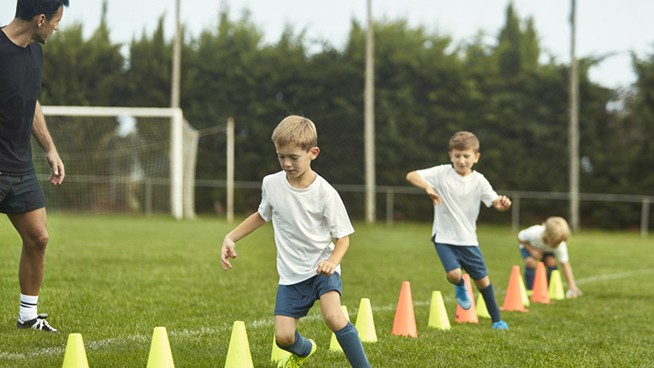5 Things You Can Do to Prevent Muscle Injuries
![]()
Muscle injuries are unpredictable. You can be going about your business, playing your sport or working out like you normally do, and then you feel a sharp pain. And it only gets worse before you realize you may have pulled—or worse, torn—a muscle.
When you push your body, there is a chance you might hurt a muscle. However, if you properly strengthen and prepare your muscles for activity and take care of your overall health, you can reduce your chance of sustaining a muscle injury.
Here are five tips based on new research you should consider to avoid muscle injuries.
1. Wear a heart rate monitor
Your heart rate variability (HRV) is the key to monitoring your fitness level. A lower resting heart rate combined with quicker acceleration to peak rate and return to baseline rate (higher HRV) is a great indicator of good cardiovascular performance and autonomic nervous system conditioning. The higher the variability, the better. Low HRV indicates fatigue and overtraining, which ultimately could lead to a muscle injury if you train too hard too fast.
New watch and smartphone technology makes it easier than ever to monitor your heart rate. Keep track of how long it takes your heart rate to recover to 125 beats per minute after an intense bout of exercise. Over time, it should lower faster, indicating that your cardiovascular fitness is improving.
RELATED: Heart Rate Training: Everything You Need To Know
2. Perform eccentric strength exercises
Hamstring tears and other muscular injuries are huge problems in all sports, leading to extensive losses of playing time. A wealth of recent studies show that eccentric exercises like Nordic Hamstring Curls can prevent muscle injury. This type of exercise trains your muscles to maintain strength and tension while they are lengthening. This helps prevent tears, which often occur when your muscle suddenly elongates and has to absorb a high amount of force.
3. Check your vitamin D levels
Low levels of circulating vitamin D are very common—77 percent of Americans are deficient—and can put you at risk for muscle strains. It’s been found that vitamin D plays a significant role in muscle function, such as electrolyte balance and protein synthesis. Poor electrolyte balance can lead to premature fatigue and injury, and a failure to synthesize protein inhibits muscle recovery. Low levels of vitamin D may also affect your strength and performance
Optimal 25-hydroxy vitamin D blood levels should be 40-50 ng/ml. Most athletes should be taking 2,000 IU of vitamin D daily, especially indoor athletes. Consult with a physician before starting any high-dose vitamin regimen.
RELATED: Why Athletes Need More Vitamin D
4. Warm up but under-stretch
The greatest myth of all training programs is that vigorous stretching prevents muscle injury. In fact, repetitive aggressive stretching actually causes muscle damage and decreases performance. It is particularly dangerous before an intense workout or sports participation, since muscles must be ready for intense activity, not just get longer. If a muscle is shocked by a sudden force or exertion of strength, it’s at a higher risk for a tear. The old dudes have it right—keep the warm-up quick and lay off the Toe Touches. Check out the video player above for a quick Dynamic Warm-Up routine.
5. Get a functional movement screening
One trend in injury prevention today is the use of the Functional Movement Screen (FMS), a battery of seven scored drills that effectively measure fitness level and can detect fatigue states. Any sign of asymmetry or a low test score could indicate a mobility issue or weakness. If you have an imbalance, another muscle group will compensate, increasing the chance of an injury because the muscle is being overworked. Two-thirds of English premier soccer teams use FMS to decrease attritional injuries.
RELATED: Intro to the Functional Movement Screen
References:
- Vilamitjana J, Lentini NA, Perez MF, Verde PE. “Heart rate variability as biomarker of training load in professional soccer players.” Med Sci Sports Exerc, 2013, 45(5): 841-850. http://www.researchgate.net/publication/264971803.
- Soligard T, Mykle bust G, Steffen K, Holme I, Silvers H, Bizzini M, Junge A, Dvorak J, Bahr R, Andersen TE. “Comprehensive warm-up programme to prevent injuries in young female footballers: cluster randomised controlled trial.” BMJ, Dec 9;337:a2469,2008.
- Simic L, Sarabon N, Markovic G. “Does pre-exercise static stretching inhibit maximal muscular performance? A meta-analytical review.” Scan J Med Sci Sports, 2013, 23(2): 131-48.
- Kirkendall DT, Garrett WE: “Muscle Strain Injuries: Research Findings and Clinical Applicability,” Medscape Orthopedics, 1999.
- McCall A, Carling C, Davison M, Nedelec M, Le Gall, F Berthoin S, Dupont, G. “Injury risk factors, screening tests and preventative strategies: a systematic review of the evidence that underpins the perceptions and practices of 44 football (soccer) teams from various premier leagues.” Br J Sports Med, 2015 (e-pub ahead of print).
- Harrison L. “A New Way to Predict and Prevent Athletic Injury.” Medscape, Feb 05, 2015.
RECOMMENDED FOR YOU
MOST POPULAR
5 Things You Can Do to Prevent Muscle Injuries
![]()
Muscle injuries are unpredictable. You can be going about your business, playing your sport or working out like you normally do, and then you feel a sharp pain. And it only gets worse before you realize you may have pulled—or worse, torn—a muscle.
When you push your body, there is a chance you might hurt a muscle. However, if you properly strengthen and prepare your muscles for activity and take care of your overall health, you can reduce your chance of sustaining a muscle injury.
Here are five tips based on new research you should consider to avoid muscle injuries.
1. Wear a heart rate monitor
Your heart rate variability (HRV) is the key to monitoring your fitness level. A lower resting heart rate combined with quicker acceleration to peak rate and return to baseline rate (higher HRV) is a great indicator of good cardiovascular performance and autonomic nervous system conditioning. The higher the variability, the better. Low HRV indicates fatigue and overtraining, which ultimately could lead to a muscle injury if you train too hard too fast.
New watch and smartphone technology makes it easier than ever to monitor your heart rate. Keep track of how long it takes your heart rate to recover to 125 beats per minute after an intense bout of exercise. Over time, it should lower faster, indicating that your cardiovascular fitness is improving.
RELATED: Heart Rate Training: Everything You Need To Know
2. Perform eccentric strength exercises
Hamstring tears and other muscular injuries are huge problems in all sports, leading to extensive losses of playing time. A wealth of recent studies show that eccentric exercises like Nordic Hamstring Curls can prevent muscle injury. This type of exercise trains your muscles to maintain strength and tension while they are lengthening. This helps prevent tears, which often occur when your muscle suddenly elongates and has to absorb a high amount of force.
3. Check your vitamin D levels
Low levels of circulating vitamin D are very common—77 percent of Americans are deficient—and can put you at risk for muscle strains. It’s been found that vitamin D plays a significant role in muscle function, such as electrolyte balance and protein synthesis. Poor electrolyte balance can lead to premature fatigue and injury, and a failure to synthesize protein inhibits muscle recovery. Low levels of vitamin D may also affect your strength and performance
Optimal 25-hydroxy vitamin D blood levels should be 40-50 ng/ml. Most athletes should be taking 2,000 IU of vitamin D daily, especially indoor athletes. Consult with a physician before starting any high-dose vitamin regimen.
RELATED: Why Athletes Need More Vitamin D
4. Warm up but under-stretch
The greatest myth of all training programs is that vigorous stretching prevents muscle injury. In fact, repetitive aggressive stretching actually causes muscle damage and decreases performance. It is particularly dangerous before an intense workout or sports participation, since muscles must be ready for intense activity, not just get longer. If a muscle is shocked by a sudden force or exertion of strength, it’s at a higher risk for a tear. The old dudes have it right—keep the warm-up quick and lay off the Toe Touches. Check out the video player above for a quick Dynamic Warm-Up routine.
5. Get a functional movement screening
One trend in injury prevention today is the use of the Functional Movement Screen (FMS), a battery of seven scored drills that effectively measure fitness level and can detect fatigue states. Any sign of asymmetry or a low test score could indicate a mobility issue or weakness. If you have an imbalance, another muscle group will compensate, increasing the chance of an injury because the muscle is being overworked. Two-thirds of English premier soccer teams use FMS to decrease attritional injuries.
RELATED: Intro to the Functional Movement Screen
References:
- Vilamitjana J, Lentini NA, Perez MF, Verde PE. “Heart rate variability as biomarker of training load in professional soccer players.” Med Sci Sports Exerc, 2013, 45(5): 841-850. http://www.researchgate.net/publication/264971803.
- Soligard T, Mykle bust G, Steffen K, Holme I, Silvers H, Bizzini M, Junge A, Dvorak J, Bahr R, Andersen TE. “Comprehensive warm-up programme to prevent injuries in young female footballers: cluster randomised controlled trial.” BMJ, Dec 9;337:a2469,2008.
- Simic L, Sarabon N, Markovic G. “Does pre-exercise static stretching inhibit maximal muscular performance? A meta-analytical review.” Scan J Med Sci Sports, 2013, 23(2): 131-48.
- Kirkendall DT, Garrett WE: “Muscle Strain Injuries: Research Findings and Clinical Applicability,” Medscape Orthopedics, 1999.
- McCall A, Carling C, Davison M, Nedelec M, Le Gall, F Berthoin S, Dupont, G. “Injury risk factors, screening tests and preventative strategies: a systematic review of the evidence that underpins the perceptions and practices of 44 football (soccer) teams from various premier leagues.” Br J Sports Med, 2015 (e-pub ahead of print).
- Harrison L. “A New Way to Predict and Prevent Athletic Injury.” Medscape, Feb 05, 2015.











